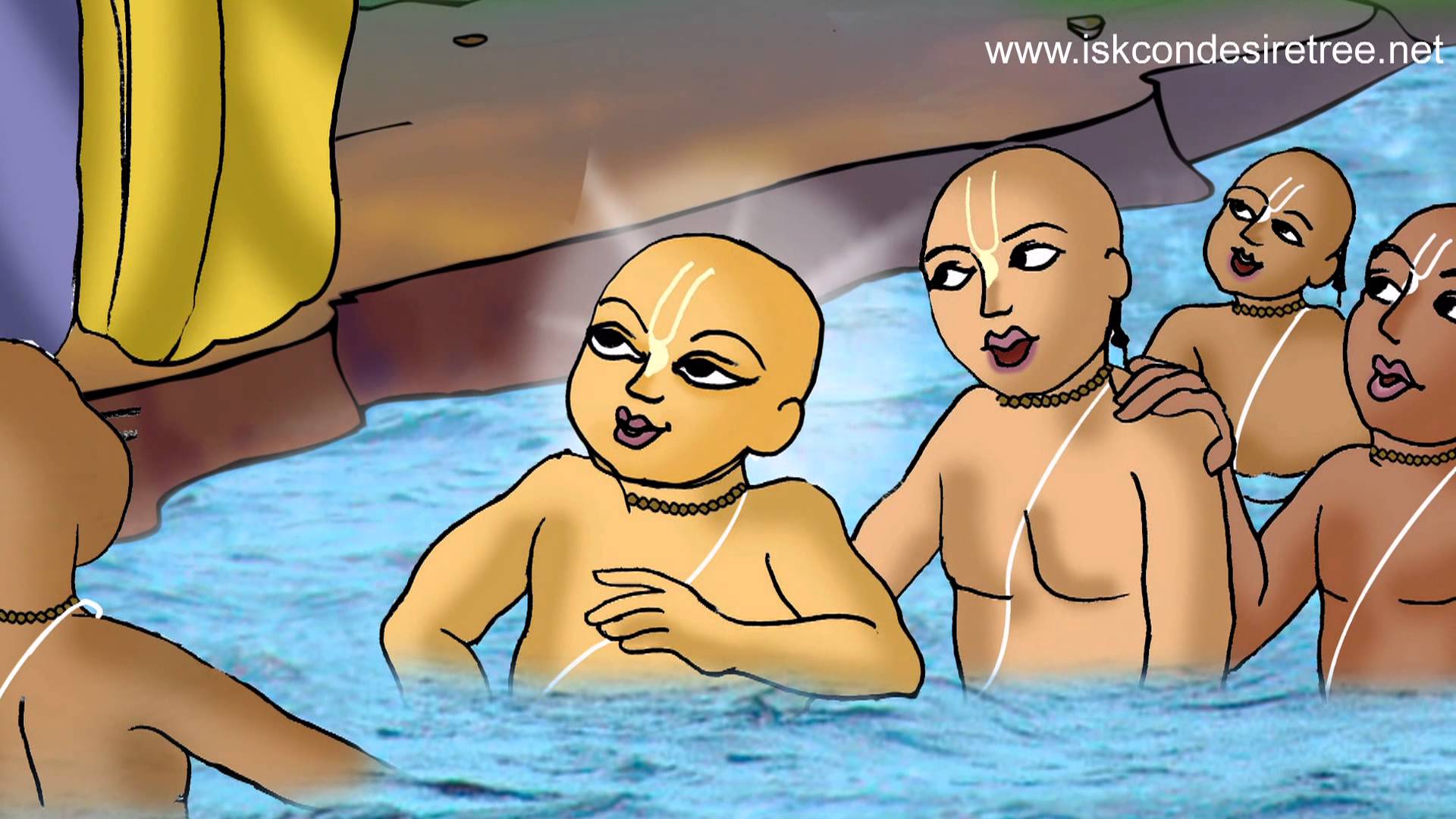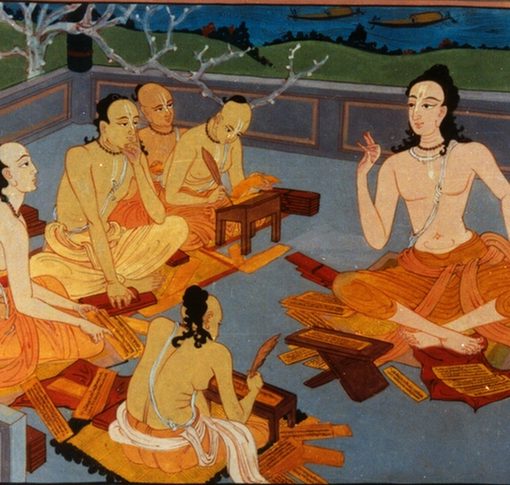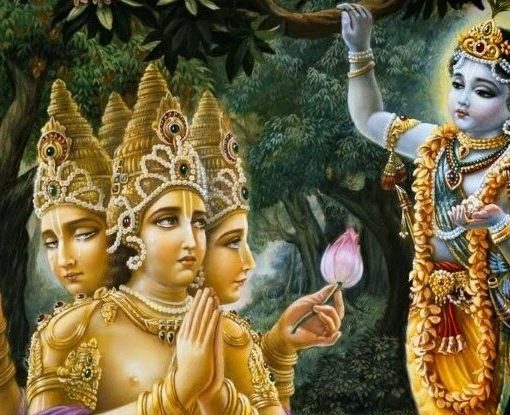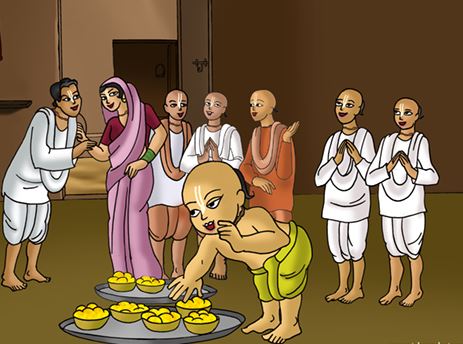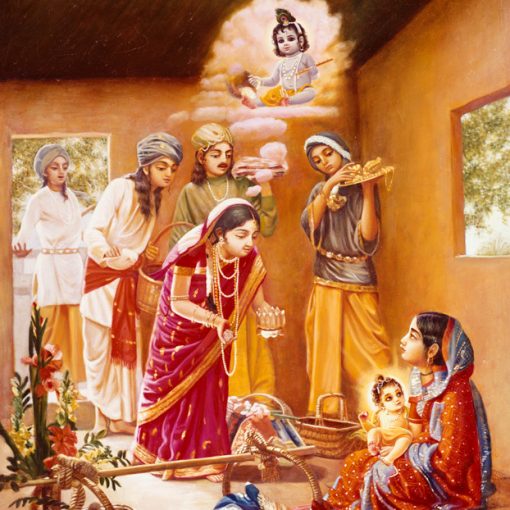An astrologer told Lord Caitanya’s father, Jagannātha Miśra, that his elder son would take sannyāsa. He was afraid that maybe Lord Caitanya would take sannyāsa too, so he thought that one way of stopping this would be that He shouldn’t be educated—let Him remain uneducated and just stay in the house. Lord Caitanya wanted to go to school and be educated, but because His parents wouldn’t let Him, He became very naughty. He was maybe only five years old, but He really wanted to go to school, so He would run around and do many naughty things.
He would go to a neighbour’s house and put water in the ear of their baby and the baby would start crying. He would go to the Ganges and when He would bathe in the Ganges, sometimes He would take all the men’s clothes and mix them with the ladies’ clothes. When they came out it was very embarrassing. Sometimes some brāhmaṇa would be chanting his Gāyatrī mantra, and Lord Caitanya would come out of the water, take water from the Ganges and spit on him. The brāhmaṇa would say, “What are you doing?” They would be very offended. And sometimes He would pull people’s legs from under them while they were trying to say their mantras in the Ganges—all kinds of little things. Of course, since He was Kṛṣṇa it was actually a blessing, but they were just seeing the external—a very naughty boy.
Another time, a brāhmaṇa was going down to the Ganges with a little banana leaf plate with some incense, Tulasī leaves, flowers, a little lamp and some different things for pūjā. He wanted to recognize his plate from everybody else because more or less everybody’s plate looked the same so he took a little ball of Ganges mud, rolled it up and put it on his plate. Then Lord Caitanya would put balls on everybody’s plate and confuse them. He would do anything He could to put pressure on His parents to send Him to school.
In those days they used to cook in terracotta pots. You may think this is a very ancient practice or a kind of rustic thing, but actually it is a much more advanced system. They didn’t have to wash pots—the pots are disposable and biologically degradable. There was no plastic or aluminium but nice clay, which is very good for cooking, it gives an even heat. After the cooking, there was a little place in the backyard where they would throw their clay pots. Then later they would cover it with dirt, and the pots would recycle into the earth. One time Lord Caitanya was standing on those clay pots and Mother Śacī said, “What you are doing? That is a garbage pit, a dirty place.” She said it was aśuci. Śuci means pure, and aśuci means an impure place.
Then the Lord replied to His mother, “What do I know about śuci or aśuci? I am not able to go to school, remember? I am not able to learn all these things. I am just an ignorant child because you are not letting me go to school, so what do I know? For all I know this is as good as any other place.” He was always trying to make His parents send Him to school, so finally Mother Śacī said, “How can we stop Him going to school? He really wants to go. Whatever His karma is we can’t really stop it as parents.” So, finally they let Him go to school. On the first day Lord Caitanya went to school He learnt all the Sanskrit consonants and vowels. Just like in English we have the alphabet, so in Sanskrit and in Bengali there is also the alphabet. It is the same alphabet in Bengali and Sanskrit, only the pronunciation of a few syllables is a little different, otherwise it is pretty much the same. The characters are a little more round otherwise the alphabets are same.
Sanskrit is a phonetic alphabet—every letter is a particular sound. If we can spell it then we can speak it. Not like English—the way English letters are pronounced can be completely different in different words. But in Bengali and Sanskrit, if you know the spelling you can pronounce the word. It is always the same pronunciation. There are no irregularities as far as the alphabet is concerned.
When Lord Kṛṣṇa was present on earth, He went to gurukula in Ujjain, at the āśrama of Sāndīpani Muni, and He learned everything in 64 days—all 64 arts, the Purāṇas and all the Vedic knowledge. In the same way, when Lord Caitanya went to school, the first day He learned all the akṣaras (Sanskrit letters). The very next day He learned all the compound letters, which usually takes much longer. He learnt so many combinations in just one day. Like that, every day He was finishing so much, so by the time He was eleven, He was already a master. Of course, the Lord already knows everything, but it is significant that He learned everything just to give the example that one must study to learn. Actually, He is the source of all knowledge: vedānta-kṛd veda-vid eva cāham (Bg. 15.15). He is the source and the purpose of the Vedas, the maker of the Vedas, the knower of the Vedas—He knows all these subjects.
Gauranga – The golden incarnation of divine love- HH Jayapataka Swami

